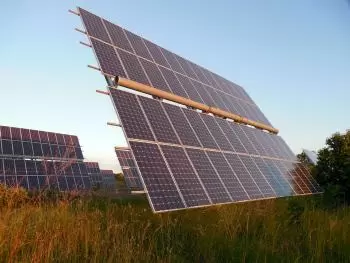
Photovoltaic cells are devices that convert solar energy into electrical energy. When photons from light energy bump into the cell's surface, they trigger an electric current moving electrons from one atom to another.
The use of this technology has increased rapidly in the last few years due to the need to replace the use of fossil fuels. For this reason, many countries have developed initiatives to promote this energy. An example of this is The National Renewable Energy Laboratory ( NREL ). It is the most crucial research laboratory in the United States for studying renewable energy and energy efficiency.
Meaning of photovoltaic
Photovoltaic is an adjective to identify everything that has to do with photovoltaic energy and the photovoltaic effect, more specifically. This concept of solar energy refers to the generation of electricity through sunlight.
The meaning of photovoltaic comes from the composition of photons and volts.
A photon is a particle that carries all forms of electromagnetic radiation, including visible light. On the other hand, a volt is a unit of electric current. In this way, it is easy to deduce the relationship between visible light or solar radiation and electricity generation.
Photovoltaic effect
The photovoltaic effect is the process by which a solar cell converts sunlight into electricity. When light strikes the cell, it creates an electric field that causes electrons to flow from one side of the cell to the other.
Since electrons have a negative charge, this flow of electrons generates an electric current that can be used to power electrical devices.
What is photovoltaic energy?
Photovoltaic solar energy is a method of obtaining electrical energy thanks to solar panels.
It is a renewable energy because all energy generated comes from the Sun. For this reason, it is considered inexhaustible, unlike fossil fuels. In addition, we do not emit greenhouse gases by producing electricity using solar cells.
A solar panel is a set of photovoltaic cells or solar cells. Photovoltaic (PV) cells are responsible for harnessing the sun's rays. They are devices that, when receiving the photons, are excited, causing electrons to jump. These electrons generate a slight potential difference.
This property is called the photovoltaic effect, which provokes the movement of negatively charged particles, the electrons.
Types of solar cells
There are many types of solar cells, each with pros and cons.
The crystalline silicon cell is the most common type of solar cell, made from silicon crystals. These cells are very efficient at converting sunlight into electricity but are also very expensive to produce.
Another type of solar cell is the thin-film cell, which is made from a thin film of semiconductor material. Solar cell efficiency is lower than crystalline silicon cells, but they are much cheaper to produce.
Finally, solar panels can be made of CIGS. It is the acronym for Copper indium gallium selenide (CuInGaSe2). It is a semiconductor material composed of Copper, Indium, Gallium, and Selenium with a lower cost than Silicon Metallurgy.
Classification and types of photovoltaic energy
Photovoltaic systems are divided into two large families:
-
Off-grid systems: they are not connected to any electrical grid.
-
Grid-connected system where it is possible to sell or buy energy.
A particular case of an isolated system is the so-called "hybrid." Hybrid solar systems remain grid-connected but mainly use their resources. They can also work with other methods, such as solar thermal, wind, and even electric generators.
It can happen that none of the sources is available or the batteries are empty. In this case, the system is connected to the grid.
Off-grid solar plant
It is used in installations isolated from other energy sources, where the grid does not reach for any reason. In this chaos, photovoltaic energy is a good solution.
The main parts of an off-grid PV system are:
-
Photovoltaic field, designated to collect energy through photovoltaic modules.
-
Storage battery or accumulator, consisting of one or more rechargeable connected batteries. The batteries allow them to retain the electric charge supplied by the solar panels.
-
Management automation: it is a unit that can automatically switch between different renewable sources.
-
Charge controller: it manages the amount of energy that goes to the battery when it is loading to keep it within certain safety limits.
-
Inverter or DC/AC converter: solar panels produce a CC. However, most of our devices need AC, and we need to convert the current.
The most used voltages in the photovoltaic field are 12 or 24 V.
Solar batteries
The solar battery is generally made up of monoblocks. However, they can also be individually designed for deep and cyclical charges and discharges.
Automotive batteries are not recommended. Despite working correctly, it has a low lifespan. In other words, they tolerate less charge and discharge cycles compared to accumulators designed for this type of use.
In the case of pole or height accumulation installations, car batteries cannot be used. Any electrolyte leakage could cause damage to people, animals, and property, for example, in public lighting systems or the like.
In these facilities, special accumulators are used in which a special gel replaces the liquid electrolyte.
Electric charge controllers
The charge controller is an electronic device and should automatically disconnect under the following conditions:
-
First, the module's voltage is less than the minimum of the charge accumulators.
-
Full recharge: the derivation of the electric current generated directly to the inverter.
-
Total discharge: when the battery is empty and needs to bypass the inverter.
Thermal solar energy
In off-grid systems, it is frequent to install PV solar panels with solar collectors. Solar collectors allow you to transform solar radiation into heat energy. These systems are used to obtain domestic hot water or heating. This is thermal solar energy.
Solar thermal energy is based on using solar energy by transforming it into thermal energy.